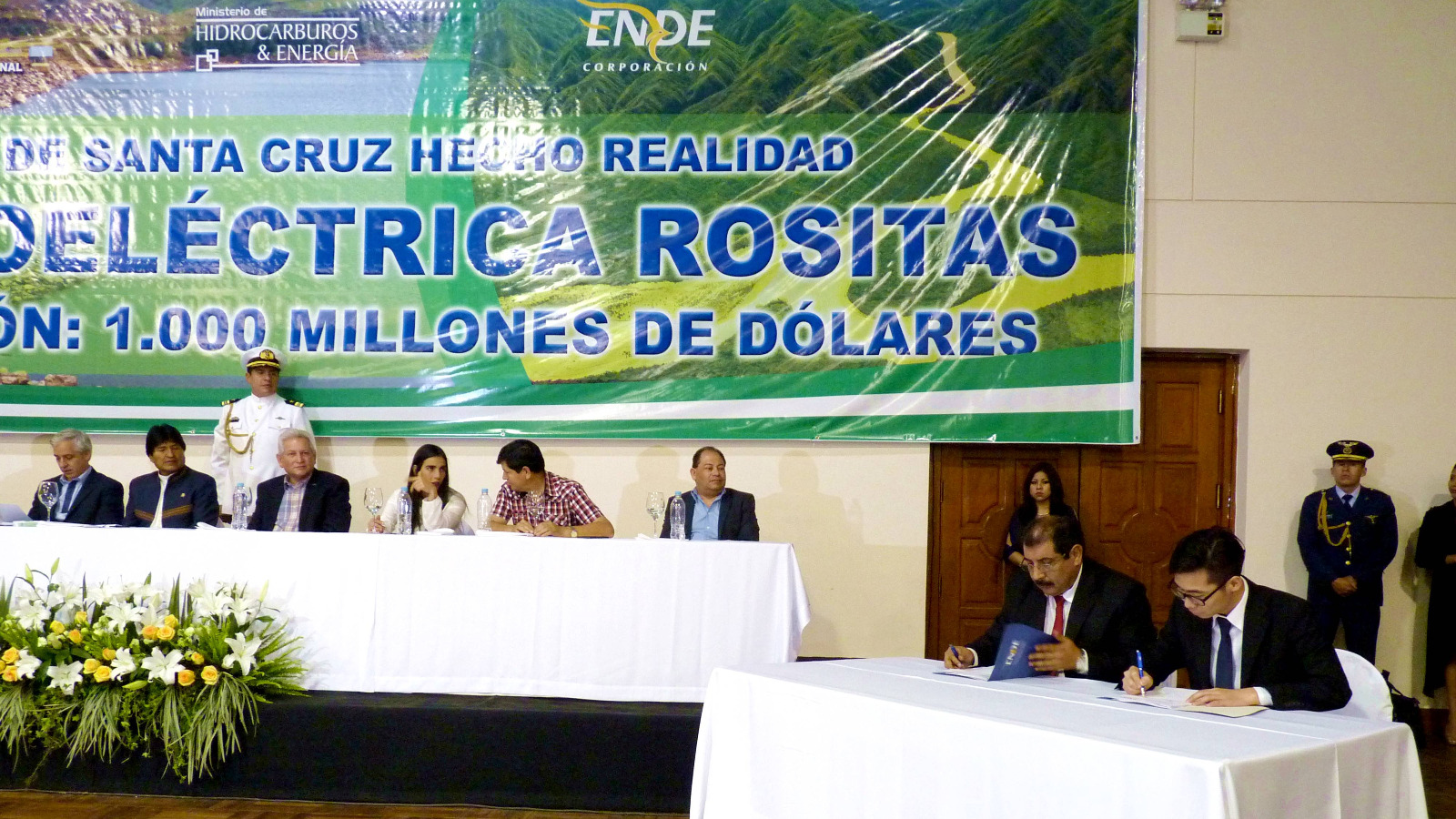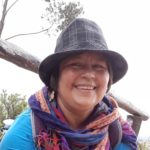The Bolivian government wants to build a hydroelectric plant in the east of the country that it claims will lessen its dependence on fossil fuels whilst guaranteeing energy and water supplies.
On December 31, President Evo Morales proposed a referendum to revive the Rositas project, which would displace communities in the department of Santa Cruz. Ever since, conflict has threatened to escalate.
Controversial project
Generating energy is a priority for Santa Cruz. With 3.2 million inhabitants, it is Bolivia’s most populous department and faces growing demand.
The Rositas project, promoted by the national government and implemented by the state-owned ENDE Corporation (National Electricity Corporation), would have serious impacts. These include the resettlement of at least 12 nearby communities that live off dairy farming and agriculture.
For the past three years, these 500 families have voiced fears about having to leave the homes they have occupied for 40 years.
For Morales, Rositas – a project originally conceived in the 1970s – remains a priority.
In 2016, the government awarded the contract to construct the dam to the AAR Consortium (Asociación Accidental Rositas), part of the state-owned China Three Gorges Corporation, along with its subsidiary China International Water & Electric and the Bolivian construction company, Reedco S.R.L. The project’s total cost is US$1.3 billion, 85% of which will be financed by the Chinese state-owned Eximbank.

On several occasions, Morales has reiterated the importance of the dam and warned it could divert resources for Rositas to other departments if it doesn’t go ahead.
“If there are some families that oppose it, why not hold a referendum and ask the department whether or not it should be done?” Morales said in departmental capital Santa Cruz de la Sierra.
Local communities immediately rejected the proposal.
“A referendum has no role in a matter like this. They had ample opportunity to hold free, prior and informed consultations. A referendum does not make sense, as it is private property,” said Benigno Barrientos, a representative of Moroco, one of the 12 affected communities.
“They have only spoken about the benefits of energy. They want to guarantee water for consumption in Santa Cruz and water for irrigation, but they don’t talk about the damage that the project will cause, nor do they talk about compensation,” said José Luis Sandoval, president of the Land and Territory Defence Committee, a community organisation set up by affected communities.
“We are rejecting it because of its lack of transparency.”
Communities against Rositas
The Rositas project is designed to generate some 600 megawatts (MW) of energy. Bolivia’s current grid capacity is 1400MW, of which it consumes 1200MW.
3000
megawatts Bolivia plans to generate as part of Evo Morales' 2025 Patriotic Agenda
However, the project has even greater ambitions. It is an integral part of Morales’ 2025 Patriotic Agenda, a plan to turn Bolivia into a regional energy hub that can generate 3000MW, exporting that not used in Bolivia to Argentina and Brazil.
Slated for construction 140 kilometres from the city of Santa Cruz de la Sierra, Rositas would be the first of seven hydroelectric dams in the Río Grande basin. The source of the Rio Grande lies in the centre of the country and flows into the Amazon to the north.
According to former Energy Minister Luis Alberto Sánchez, beyond generating energy the dam would irrigate 164,000 hectares of agricultural land, supply drinking water to Santa Cruz and reduce the risk of flooding downstream.
So far, neither ENDE nor the government has released information on the potential impact of the project. However, a study by the NGO Fundación Solón identifies a 452-square kilometre affected area that straddles five municipalities: Gutiérrez and Cabezas in the Cordillera province, Postrervalle and Vallegrande in Santa Cruz’s Vallegrande province, and Villa Vaca Guzmán in the neighbouring department of Chuquisaca.
Farming communities initially became concerned in 2012 when an initial feasibility study showed a 45,000 hectare area that would be subject to flooding.

They also fear the loss of existing infrastructure, including schools, roads, and power lines. A 38 million boliviano (US$5.5 million) bridge over the Río Grande, which is almost operational, is located in the area to be flooded, according to NGO Probioma.
The bridge joins the municipalities of Vallegrande and Gutiérrez and has been promoted by the Bolivian Roads Authority as a means of transporting products such as corn, potatoes, peanuts, and other vegetables to markets in Santa Cruz, Bolivia’s second city.
In December 2016, at a gathering in the indigenous community of Tatarenda Nuevo, the Committee for the Defence of Land and Territory of Communities Affected by the Rositas Project voted to reject construction of the project owing to its impacts.
They say there has been no free, prior and informed consultation on the project, as mandated by Bolivia’s Constitution and the International Labour Organization’s (ILO) Convention 169 on indigenous people, which Bolivia has ratified. Three of the affected communities are indigenous Guaraní.
Faced with what they describe as unresponsiveness to requests for information on Rositas’ impacts and alternatives, in May 2017, the Committee decided not to attend any further gatherings related to the project.
From that moment, the communities’ struggle became a legal matter. In March 2018, the Guaraní communities of Tatarenda Nuevo and Yumao took them to court for violating their rights.
After going through three different courts, a judge ruled against the complaint, arguing; “the plaintiffs cannot be considered affected when there are no regulations, or an active project, nor can they claim to be affected until studies are concluded that must be carried out by ENDE prior to the consultation”.
No referendum should deal with something that is illegal
The studies are not publicly available, nor have they been completed.
The first, a final design study that establishes the affected area, was carried out by the company Eptisa, but to date, it has not been published. The status of the second, the environmental impact assessment, is uncertain despite ENDE subsidiary Corani S.A. winning the contract to carry it out in August 2017.
Finally, the study for the irrigation project involving 165,000 hectares of agricultural land was awarded in January 2018 to Spanish consortium Inclam S.A. for US$2.4 million with funds from the Development Bank of Latin America (CAF). It is expected later this month.
Indigenous communities say the courts did not take into account documents substantiating how they would be affected by the flooding and their “involuntary re-settlement”.

Environmentalists are also worried about the project’s impact on the humid forests of the Río Grande basin. The affected area encompasses three protected areas: the Iñao National Park; the Río Grande Integrated Area– Valles Cruceños; and the Parabanó Municipal Protected Area.
“Protected areas are enshrined in the Constitution and there are other regulations that forbid activities being carried out,” said environmental researcher Cecilia Requena, co-author of the book ‘Bolivia in a 4-degree warmer world’.
“No referendum should deal with something that is illegal. That is, carrying out infrastructural work or any public work that affects the function for which it has been created,” she added.
Cleaner energy for Santa Cruz
Rositas would enable Bolivia to significantly transform its energy matrix.
The government says new hydroelectric plants would replace energy generated by natural gas and diesel with water, a renewable source. In doing so, it would cut greenhouse gas emissions that cause climate change. Today, gas- and diesel-powered thermoelectric plants produce 75% of Bolivia’s electricity.
The Defence Committee’s opposition to Rositas is awkward for the government.
“We call on the Santa Cruz people to defend their project —the dream of the old people who envisioned this project,” said Energy Minister Rafael Alarcón, who described those filing legal action against Rositas as “bad people”.
ENDE, the energy ministry of Energy, and the governing body of Santa Cruz say they will find out who should be compensated by the project and stress the measures to prevent environmental degradation.

Communities, however, say information is vague.
“We are not aware of any proposals. We don’t have to accept anything if we don’t know about it,” said Benigno Barrientos, vice-chairman of the Defence Committee. “At no time have we been shown the best or the worst [scenarios]. What private owner is going to hand over his property without a proposal?”
They insist that rather than the referendum, there must be a process of prior consultation.
“Our position is that any attempted consultation now is wrongly timed, bearing in mind that consultation with indigenous communities should have taken place beforehand,” said Ena Taborga, representative of the Guaraní community of Tatarenda Nuevo. She added: “Consulting all Bolivians would violate, among other rights, our self-determination.”
Sara Crespo, a researcher at Probioma, agrees: “It was not done beforehand. That right is already violated and nothing is being done to provide compensation.”
No Santa Cruz native, no Bolivian, is going to like the government taking away an inherent right by a referendum
Nor do many believe the government will comply if the result goes against them. Morales lost a February 2016 national referendum on whether he could seek another presidential term. He will run for office again in October this year.
The government says the referendum would take precedence but insists on the importance of considering agreeable alternatives.
“There has to be consensus between the different levels of government and the affected population in order to seek positive solutions and avoid a referendum,” said José Luis Parada, an advisor to the Santa Cruz government.
He added: “Nobody is going to oppose the implementation of 200,000 hectares of irrigation, generating energy, or having public and private electric transport. The referendum is secondary to the importance the project will have.”
For the time being, attempts at dialogue are paralysed. The Ministry of Energy did not respond to Diálogo Chino’s request for information on what action they will take to make Morales’ referendum proposal viable, merely pointing out that they are collecting water data.
Meanwhile, anti-dam protesters’ frustration at the lack of information on Rositas simmers.
“No Santa Cruz native, no Bolivian, is going to like the government taking away an inherent right by a referendum. For three years, we have asked for proposals but have got none,” said Benigno Barrientos.

